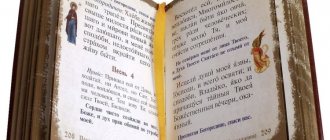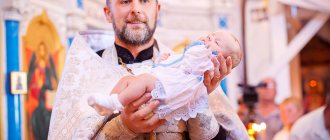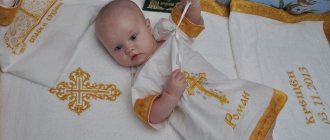At what age is it better to baptize a child?
| The opportunity to receive God's grace through baptism is given to a person from birth. It is believed that the sooner the baby has a Guardian Angel, the better. As a rule, baptism of a newborn is carried out on the eighth or fortieth day of life. Most often, it is the second option that is preferred by young parents, since until the 40th day after giving birth the woman remains in physiological impurity and is not allowed to participate in church sacraments. After 40 days, a cleansing prayer is read over the young mother, after which she is again allowed to visit the temple and attend the baptism of her baby. Some parents are in no hurry to baptize their child, giving him the opportunity to grow up and get stronger. But you shouldn’t delay it, because as children grow older, they begin to get scared of new people and being in unfamiliar surroundings, so they can behave restlessly. |
Requirements for a godmother
Work as a courier at Yandex.Eda (up to 3,400 rubles per shift) leave a request →
The woman who is planning to be taken as a godmother must be warned about this in advance of the ceremony. After all, she needs not only to know the text of the prayer, but also to understand the very essence of Baptism. And, it goes without saying that only a woman who reveres Orthodoxy, who lives according to God’s commandments, can receive such a high honor. She must have knowledge of certain prayers that define the essence of Orthodoxy. First of all, these are the prayers to the “Heavenly King”, “Rejoice to the Virgin Mary”, “Creed” and, naturally, “Our Father”.
What day should I schedule my child's Baptism?
Baptism is possible on any day of the year, periods of fasting and Orthodox holidays, but in some cases the priest may recommend postponing the date of baptism:
- if it coincides with great or twelve holidays, when the church is crowded and services are longer;
- During the periods of strict Great Lent and Dormition Lent, the sacrament is scheduled for Saturday and Sunday.
Epiphany during Lent presupposes a Lenten menu, which must be taken into account when preparing for the celebration.
What things will be needed in the temple?
- Candles. They must be consecrated before Baptism begins. You can buy candles in a church shop, then there is no need to consecrate them.
- Christening shirt. For girls - christening dress. It must be new (the exception is if the baptismal dress is your family heirloom and was passed on to the baby from older children in the family).
- Cross and gaitan (lace). For the safety of the child, the cross should have rounded edges. Crosses purchased at a jewelry store must be blessed. Those purchased in the temple, as a rule, are already consecrated.
- Kryzhma (diaper, towel). The child is wrapped in it after dipping into the font. To ensure that all the details match each other in color, you can buy a ready-made baptismal set. All its details are decorated with lace and personalized embroidery.
- A cap or headdress (for a girl, if she is over 1 year old).
- Diapers.
- Diaper (can be placed on the changing table).
- Warm blanket (relevant for cool weather).
- Water, formula or other usual food (you are allowed to feed the child before and after the sacrament).
After Baptism, another pleasant part begins - the presentation of gifts and a festive feast. It's full of treats, but in the center is a sweet cake with the baby's initials and christening date.
Choosing godparents
A tradition has developed that a pair of godparents is chosen for a child, although, according to church canons, the godfather can be one person of the same sex as the person being baptized.
For children from birth to 12 years of age, the presence of a recipient at baptism is mandatory, since a child at this age is not able to understand the essence of the sacrament. Godparents make vows for him before the Almighty and thereby take on the responsibility of introducing him to the Orthodox faith.
It is better to choose a recipient from close friends or relatives so that over the years the connection with him is not lost:
Parents need to carefully consider the choice of godparents, and the godparents themselves need to go through public conversations and decide for themselves whether they are ready for the assigned responsibility. Refusing to be a recipient is not a sin. Worse is not keeping your promise to the Lord. |
Who shouldn't be a godfather?
The rules for baptizing a child in the Orthodox Church provide that adult Orthodox believers become recipients. The following cannot be godparents:
- parents of their own child;
- unbaptized people until they accept faith and undergo the rite of baptism;
- minor children who do not fully understand the significance of worship;
- husband and wife, as well as a couple planning to get married, since a spiritual relationship arises between the recipients, which is higher than other ties, even marriage ones;
Is it possible to baptize a child on critical days?
It is important to choose the date of christening so that the child’s mother and godmother are in physiological purity, because on the days of monthly cleansing it is forbidden to touch shrines and participate in church sacraments. If the critical days come unexpectedly and the date of baptism cannot be shifted, then the godmother must tell the priest about this. Most likely, she will be allowed to attend the sacrament, but without the opportunity to hold the child in her arms and venerate the icons.
Baptism of a child: what parents need to know
How is the sacrament of baptism performed? What spiritual meaning does it carry? What do parents of a baby need to know? What is required from godparents? What are the basic requirements and main taboos?….
These questions concern those who themselves are going to accept the rite of baptism or baptize their children. The Orthodox priest, Archpriest Vasily RUSINKA answers these important questions
What do parents who want to baptize their baby need to know? Why is Baptism necessary?
First of all, this is the beginning of spiritual life, a kind of “pass” to heaven - the Kingdom of God. A newly enlightened person receives remission of previous sins, the original sins passed on from Adam to all his descendants, and sins committed consciously (for an adult). That is why Baptism, among all the Sacraments, is the first sacrament and is necessary for every person seeking salvation and the meaning of life.
Without what is Baptism impossible?
Without faith! For an adult, baptism without faith and repentance is impossible. Children are baptized according to the faith of their parents and godparents, who, in turn, must themselves be baptized. In order not to get confused on the day of christening, it would be very useful for future godparents to read the Holy Scriptures in advance, in particular, the chapters about the earthly life of Christ and His Baptism. If you have been invited to become a godfather, do not be confused, but go to the temple. Approach the ministers; no one will refuse you advice or help. And if your soul is not ready for active interaction with representatives of the church, you can simply stand silently at the icon, ask for help and admonition.
What happens during the sacrament?
At the very beginning, a prayer “for naming” is said, in which the priest asks God so that the little man bears his name with dignity, and does not scold it and thereby not offend his patron saint. A person’s name distinguishes him from billions of other people and affirms the uniqueness and uniqueness of his personality, for our Lord Jesus Christ suffered for him too. The naming ceremony recognizes the uniqueness of this particular child who has acquired the Divine gift of personality. At all times, the name of a Christian was considered holy, and therefore from childhood he was taught to respect his name.
Thus was born the tradition of giving the baptized person the name of a saint, who thus becomes his heavenly patron and intercessor. It is unreasonable to give children nicknames, calling them pretentious and exotic overseas names of TV series characters. The priest will give such children a second name, Orthodox. (It is important to know that after baptism a person acquires a guardian angel, the baby can already be given communion. Find out on what day the memory of this saint is celebrated - do not forget to congratulate the baby on Angel Day. It is best to purchase a church calendar.)
Further, through a visible action - immersion in water and anointing - the supernatural grace-filled gifts of the Holy Spirit are invisibly communicated. Immersion in the font can be complete three times (which is preferable), if, of course, the conditions in the temple allow, or three times pouring over the head, for example, for children.
At this time, the main words (formula) of the sacrament are pronounced: “The servant of God (name) is baptized.” In the name of the Father. Amen. And the Son. Amen. And the Holy Spirit. Amen".
Thus, the baptized person becomes completely new, reborn for a new life dedicated to goodness and God. After the font, the forehead, hands and feet of the person being baptized are anointed with holy myrrh. The patriarch prepares myrrh once a year, during Holy Week (before Easter), from oil, wine, fragrant herbs and aromas. After anointing, a lock of hair is cut from the head, which remains in the temple as a pledge of dedication and a symbol of sacrifice to God. If a child is being baptized in the cold season or conditions do not allow him to undress (low temperature in the baptism room), free the baby’s arms and legs in advance.
By the way
The Church prays for its children, people who have been baptized, but for the unbaptized, people of other faiths (people professing other religions), as well as those who died as a result of suicide, you can pray at home, privately.
How to choose godparents?
A godfather in Slavic culture is a godfather. After immersion in the font, the priest transfers the baby from his own hands to the hands of the godfather. The meaning of this action is very deep. By acceptance, the godfather takes upon himself the honorable, very responsible mission of leading the godson along the path of ascension to the Heavenly inheritance.
When choosing a godfather for your baby, find a person whom you completely trust, preferably an Orthodox believer. (You should not seek only material benefits in nepotism.) These could be your close friends or relatives with whom you constantly maintain good relations. According to church tradition, godparents become the child's guardians in the event of the death of the parents. For a girl you can find only one “mom”, for a boy - “dad”. At your request there can be two, four, six...
Separately, it is necessary to say about the clothes of the godparents.
In the traditions of the Slavic peoples, women always had a covered head and a long dress in the temple (little girls may be an exception). Don't let the good old ways become a burden for you, because your nice trousers and new fashionable haircut can be shown off in other places. In church, it is better not to attract attention to yourself, focusing on the purpose of your parish, that is, on prayer.
Don’t take the comments of local old ladies too seriously - they often do not stand on ceremony with fashionistas, so it is better not to provoke them, respecting their advanced age.
Give your godson your time
Unfortunately, not every godparent understands why his new “position” is called that way. Visiting your godson and giving gifts on an angel’s or birthday day is, of course, good. However, this is far from the most important thing. Caring for a growing godson involves a lot.
First of all, this is a prayer for him. Learn to turn to God once a day - before going to bed. It's actually not difficult at all. Ask the Lord for health, salvation, help in raising your own children, the well-being of godchildren and relatives. It will be useful to master the path to the temple together with your child and take him to communion on a church holiday. It would be great to play educational games with your baby and read books to him. For example, many adults enjoy reading the children's Bible. It clearly describes all the main events of Sacred History.
In addition, godparents can make life much easier for young mothers who find it difficult to find time to spend with their baby. For example, in the first months our godmother tried to use her break at work to come running to us - to take a walk with the baby, to give me the opportunity to do work or just relax. She also devoted her free days or weekends to us. I think that if everyone, to the best of their ability, spends their free hours communicating with the child, they themselves will enjoy it.
What prayers do you need to know?
Every conscientious Christian needs to know the basic prayers: “Our Father”, “Virgin Mother of God”, “Creed”. During baptism, the godparents say the “Creed” prayer for the baby. All these prayers are in a short prayer book, which can be purchased at the church store if desired.
What to bring to the temple?
As already mentioned, baptism is birth into a new sinless life. Receiving the newly baptized person from the holy font, the godparents accept an absolutely pure being, without sin. A symbol of such purity is white clothing - kryzhma, which is brought to the temple along with a cross on a chain or thread. Who should buy a cross and who should buy a chain, let the godparents decide for themselves. At the end of the ceremony, the priest will bless them and put them on the baby.
An openwork diaper or a new towel that has not yet been washed will serve as a cover for a small child. Today there are very cute baptism sets for children in supermarkets. In Greece, for example, Christian culture is deeply embedded in life, and baptism, like other church rites, always looks very elegant. There they prepare for the sacrament of baptism in advance: they collect suitcases with baptismal clothes. For boys, these suitcases with yachts, for example, for girls with flowers. Children are baptized when they are already grown up: at 6 months or at 1-1.5 years. When everyone returns home after the christening, the suitcases are placed near the entrance so that gifts for the newly baptized person are placed in them. On the tables there are tall baptismal candles with baptismal bows on them; they are also available for a boy or a girl. Baptismal candles burn all day. On the tables there are vases with sweets or small toys for guests who came to the christening.
But let's return to Russia.
So, if the baptismal room is warm, then most likely your little one will be dipped naked. But when it is cold in the temple or an adult is being baptized, only the neck, arms and feet are exposed for anointing.
In some churches there is a tradition: to bring red wine or bread to baptisms as a symbolic donation, and also to hold lit candles during baptism. Ask the temple servants about these details in advance. Many godparents are embarrassed when the baby cries at baptism. Do not forget that children are “nervous” in an unfamiliar environment, often due to the absence of their dear, irreplaceable mother nearby. If she (the mother) is still there, and the baby is at risk of becoming hoarse, let her calm the child down. The priest can interrupt the ceremony and give the baby the opportunity to come to the “appropriate” state of mind. But during the baptism of the child, only godparents hold the child.
Advice.
Keep the baby's baptismal cover and clothes as a keepsake. Do not use it for household purposes. Since drops of myrrh could remain on the clothes, you cannot wash them, so as not to commit a sin - keep them as a shrine.
Where to perform the sacrament of Baptism?
| The child’s parents choose the venue at their own discretion. Small churches are preferable because they are visited by fewer people and there is the possibility of choosing a suitable date, and it is also easier to organize an individual sacrament. Parents need in advance:
|
How to prepare a child for baptism
From the point of view of Orthodoxy, no preparation is needed. You need to prepare the child mentally for the ritual itself so that he does not get scared, start crying or throw a tantrum. A priest in a long robe, burning candles, huge icons - all this can very frighten a child.
Talk to the priest and ask to spend 15 minutes before the ceremony in the room where the sacrament will take place. Let the child get used to the place. If this is a baby, let the mother hold him in her arms and show him everything around. Let the child also get used to the priest himself. You can tell an older child something, or even better, visit the temple with him a couple of times the day before.
The same applies to godparents. It will be very good if, closer to the christening date, they communicate more with the child, so that he perceives them as “his own” and is not afraid to go to his arms.
What will be needed for the baptism ceremony?
According to church rules, to baptize a child you need:
- Baptismal clothing - a shirt, kryzhma (diaper or towel), which the godmother purchases in advance. The girl will also need a headdress: a cap, a headscarf, a scarf, a stole.
- Pectoral cross on a string or chain. The godfather must buy it. It is necessary to choose an Orthodox consecrated cross. The unconsecrated cross is consecrated by the priest immediately before the start of the sacrament.
Additionally, for the ceremony you will need candles and an icon of the heavenly patron as a gift to the godson, and you will also need to make a donation for the sacrament.
Other accessories, such as socks, booties, a warm knitted blanket, and children's Orthodox literature, can be purchased as needed and at your own discretion.
The day before the christening, future godparents must confess and receive communion in order to spiritually cleanse themselves before the upcoming event.
Holy Baptism
A person’s acceptance of the Christian faith passes through the sacrament of Baptism, the meaning of which is to free a person from original sin. This ritual is performed only once in a lifetime. This tradition arose many centuries ago, and although it has undergone certain changes, it has still retained the basic rules and canons.
The essence of Christianity is ritual immersion in water, because it is believed that a person immersed in water becomes cleansed of his sins. The Epiphany rite, like several centuries ago, is performed by a priest. In most cases, this sacrament takes place in the Church, but it is not prohibited to perform it at home. As a rule, Baptism takes from forty-five minutes to an hour. According to established traditions, it is strongly recommended that a child be given only a Christian name.
Recommendations for choosing a church name: traditions and rules
Usually the already named child is baptized. If the baby’s name is Orthodox, then the priest identifies the heavenly patron among saints with the same name. When the name by which the child is named is not in the Orthodox calendar, the priest suggests choosing a church name for him:
The naming prayer precedes baptism. Further, it is the Orthodox name that is used in all church sacraments, and is also mentioned in prayers for the child. |
What name to choose for a child at baptism
The child can choose any name that is in the list of names of Christian saints. You can focus on traditions by choosing a name that is in the calendar on the eighth day from birth, on the birthday itself. You can name it by the name of the saint to whom you prayed or from whom you asked for a child. It can also be in honor of a saint whose life and deeds inspire you.
You can choose a name that you just like.
You may have heard that it is better not to name children after saints who faced martyrdom. The priests consider this to be superstition and even, on the contrary, say that the patience and courage of such saints is worth admiring.
Another argument against such a superstition is the fact that there can be many saints with one name, although their fates were different.
The name given at baptism may differ from the one recorded on the birth certificate. It will be used by godparents and relatives in their prayers.
How should parents and godparents dress properly for a child’s baptism?
In Orthodoxy, there are certain rules regarding clothing for going to church, including for the baptism of a child. Mother and godmother should choose a modest, neat outfit, adhering to the following recommendations:
- A headdress is required. This could be a headscarf, shawl, or stole of subdued colors.
- The dress or skirt should have a loose fit, without deep slits or see-through inserts, and the hem should cover the knees.
- You should choose a top with a closed collar and shoulders.
- Shoes should be closed and low-top. In high heels it is difficult to withstand service with a child in your arms.
- Provocative makeup and lipstick are not allowed. It is prohibited to touch the cross and icons with painted lips.
Men should also appear clean and tidy. Visiting church in a T-shirt, shorts, or sports shoes is not encouraged. All those present in the church building must have crosses.
Responsibilities of the godmother at baptism
The requirements for the named mother when baptizing a girl and a boy have been slightly changed.
This difference lies in the actions after dipping the child into the water: if it is a boy, then the godfather takes him, and if it is a girl, the godmother takes her. All other responsibilities are the same.
- Thus, during baptism, it is required that the godmother be dressed in a discreet long-cut dress, and her head must be covered with a scarf.
- After lowering the child into the water, the woman needs to take her goddaughter in her arms and dress her in white clothes.
- The godmother should hold the child while walking around the font and during the prayer service, as well as during the anointing with oil.
- The godmother must understand that after Holy Baptism she is destined to become a spiritual mentor in the difficult life path of her godson.
Features of celebrating children's christenings
It is customary to celebrate the sacrament of a child's baptism with a festive meal. Previously, such a lunch was held directly in the church. Today this rule is rarely observed, since not all churches provide this service. The celebration of christening usually takes place at home or in a cafe or restaurant in a calm atmosphere, without protracted feasts and wild fun. It is allowed to celebrate a joyful event with one sweet table, because, first of all, this is a children's holiday.
On the day of baptism, it is customary to wish the child health, happiness, prosperity and present gifts, preferably with spiritual content. For example, you can give a children's Bible, a prayer book, an icon, a sippy cup, a silver spoon, a toy in the shape of an angel, etc.
Parents and godparents should remember the date of the baby’s baptism and celebrate it annually, because this day is considered the Child’s Angel Day. A good hint would be personalized embroidery with a date on the baptismal shirt, diaper or bag for storing baptismal clothes.
After baptism
After baptism, parents usually gather relatives and godparents at the festive table. You can do this at home, in a cafe or restaurant, in nature or in the refectory of a monastery. Focus on the age of the child and traditions in your family. The main thing is your comfort and convenience.
Don't forget to give your godparents at least symbolic gifts as a sign of gratitude for their responsibility.
That's all the basics that parents need to know before baptizing a child.
Photo and video recording of the sacrament as a keepsake
It would be appropriate to capture the bright sacrament of baptism in photographs and record it on video in order to show it to a grown-up child in the future. At the same time, we recommend that you foresee important points in advance:
|
Photos courtesy of Olesya Panteleeva.
How the ceremony goes - step by step
- At the beginning of the ceremony, the priest reads prohibition prayers, in this way, in the name of the Almighty, driving out Satan from the person being baptized.
- Then the baptized person, or named parents on his behalf, renounces Satan three times, three times declaring reunion with Jesus Christ as God and King.
- The Creed is read three times, which sets out the essence of the confession of the Orthodox faith.
- Then the priest consecrates the water and oil - oil. Oil is used to anoint the person being baptized, after which he will be in the tree of the Church of Christ.
- Three times the baby is lowered into the water, from which he is placed in a baptismal swaddling cloth - kryzhma.
- Next comes the Sacrament of Confirmation.
- During the reading of the Gospel, tonsure is performed: the priest cuts off a small lock of hair from the child.
- At the end of the ceremony, as a sign that the baby has already become a Christian, he is given a cross.
- Prayers for a child's baptism;
- Rules for baptism - on what dates it is possible;
- How to dedicate a cross.











